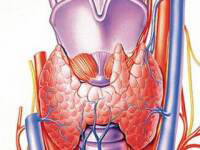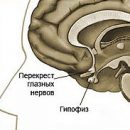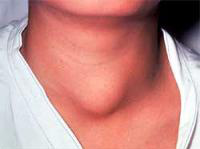Thyroid cancer, despite the fact that in recent years it is found much more often, yet does not apply to the number of malignant forms. The overwhelming majority of people with thyroid cancer patients were previously detected benign neoplasms (goiter, adenoma).
Content
Concept of thyroid cancer
Thyroid cancer do not refer to the number of frequent forms of malignant tumors, although in recent years it is seen somewhat more often, especially in childhood. Sick more often in old age. In people over 40 years of age, the frequency of the recorded cancer nodes increases by 10% in each subsequent decade. Benign nodes and thyroid cancer are more common in women. Suspicions of the misstatement (Malignation) of the node more often confirm in men. Some thyroid carcinomas are heard.
Previous diseases in the overwhelming majority of patients are benign neoplasms of the thyroid gland (goiter, adenoma, proliferating cystadenoma). An indirect confirmation is the high frequency of cancer in areas where the endemic goiter is distributed. A special tendency to zero-quality exhibits proliferating papillary cystadema.
Malignant thyroid tumors are very variable in its structure, although the epithelial forms of cancer prevail. There are three groups of tumors in the degree of their malignancy. Tumors are low-quality, or potentially malignant, referred to the above-mentioned papillary cystadenomes, which, despite the benign building, have the ability to repeat recurrences and turbulence in blood vessels. Degenerate adenocarcinoma and malignant adenoma developing in their illicitality and malignant adenoma to the group of medium-quality. Melletoque and anaplazed cancer forms belong to high-quality forms. The last group includes the sarcoma of the thyroid gland of various buildings, including lymphosarcomas.
The main manifestations of the disease
 Clinical symptoms in the initial stages are almost not expressed. It should be borne in mind that many malignant tumors arise against the background of a long existing benign goiter. Some of the first objective symptoms are the rapid increase in the already existing node, its seal and the pegrister.
Clinical symptoms in the initial stages are almost not expressed. It should be borne in mind that many malignant tumors arise against the background of a long existing benign goiter. Some of the first objective symptoms are the rapid increase in the already existing node, its seal and the pegrister.
Often, when inspection, the patient detects asymptomatic and progressive node in the thyroid gland. In this case, a malignant tumor should be suspected (despite the fact that the unit nodes of the thyroid gland are in most cases benign).
In a healthy gland, the tumor assembly occurs usually in one of the pieces, more often in its lower pole; less often it appears in the cage of glands and distributed in both shares. The tumor is first represented by a rounded, smooth and has a more dense consistency than the tissue fabric. With increasing it becomes a bug, loses clear boundaries and captures one or both shares. More often, the tumor growth is going by the stop, where it, a sparkler gland capsule, squeezes the return nerve and the trachea, causing witness of the voice, the difficulty of breathing and shortness of breathing during exercise. In cases of compression of the esophagus, swallowing and dysphagia (swallowing) occurs. In the future, the muscles of the neck, fiber and vascular-nervous beam are involved in the tumor process. The skin appears a thick network of sharp extended veins.
The increase in lymph nodes on the side of the lesion implies. In children, more than 50% of cancer cases are first diagnosed in connection with the increase in cervical lymph nodes.
Paralic of voice ligament on the side of the node - always a sign of cancer, infiltrated returnable guttural nerve. Since the vocal ligament paralysis can leak without violation of the voice, the voice gap should be examined by direct laryngoscopy.
Methods of diagnosis of the disease
To confirm the diagnosis of a malignant tumor of the thyroid gland, first of all of its cancer, a number of additional research is carried out.
The study of the functions of the thyroid gland during suspected cancer does not have great value. Most of the malignant gland tumors do not have hormonal activity, as well as adenomatous hyperplasia.
In the early stages, the diagnosis is based on an increasing tumor in one of the stakes of the gland (or previously existing goiter), its bugger, restrictions of mobility, feeling of tension in the thyroid gland and a feeling of choking.
A large place in the diagnosis occupies radioisotope scanning of the thyroid gland with radioactive iodine, in which the focus of the tumor is presented in the form of a defect accumulation of isotope. However, radioisotope scanning does not allow differentiate benign «Cold» nodes from malignant. This method acquires this method in the diagnosis of thyroid cancer metastases under the condition of their ability to accumulate iodine-containing drugs and the absence of the tissue of the gland itself, previously remote surgically.
Penal biopsy - the most accurate (with the exception of a surgical operation) The method of differential diagnosis of benign and malignant thyroid nodes. Morphological diagnosis is set by a tumor puncture or a metastatic node on the neck and thus the clear idea of the histological form of the tumor and the degree of its prevalence. Only if it is impossible to establish an accurate diagnosis of cancer (lack of clear symptoms, the failure of the cytological research) resort to histological examination during the operation and, depending on its results, the issue of intervention is resolved.
To determine the degree of damage to the return nerves resort to laryngoscopy (inspection of larynx, voice ligaments). The establishment of a paralysis of the voice ligament indicates the involvement of the nerve into the tumor process. With the same purpose, and in order to inspect the trachea and determining the degree of its narrowing, bronchoscopy can be used.
Sometimes radiological techniques are used. These should include pneumography of the thyroid gland, allowing to clarify the germination of the surrounding tissues, and angiography, detecting violations of the vascular network, characteristic of malignant neoplasms. The trachea radiography and the contrasting study of the esophagus with a barium to establish pressure or germination of a tumor.
Recently, a wide distribution has received an ultrasound study (ultrasound) of the thyroid gland. With it, it is difficult to distinguish cancer from other nodal formations, but due to its safety and high bandwidth, it is widely used in preventive inspections of high-risk groups. Ultrasound allows you to identify nodal formations in the thyroid gland, not detected during palpation, and perform a targeted puncture biopusion of the node.









